

Asuka period. Nara period. The Nara period (奈良時代, Nara jidai?)
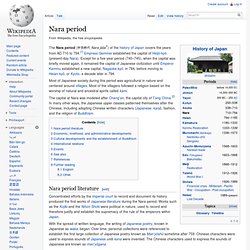
Of the history of Japan covers the years from AD 710 to 794.[1] Empress Gemmei established the capital of Heijō-kyō (present-day Nara). Except for a five-year period (740–745), when the capital was briefly moved again, it remained the capital of Japanese civilization until Emperor Kammu established a new capital, Nagaoka-kyō, in 784, before moving to Heian-kyō, or Kyoto, a decade later in 794. Most of Japanese society during this period was agricultural in nature and centered around villages. Most of the villagers followed a religion based on the worship of natural and ancestral spirits called kami. Heian period. The Heian period (平安時代, Heian jidai?)
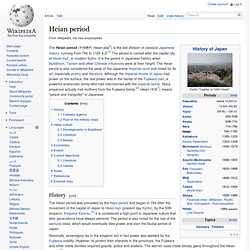
Is the last division of classical Japanese history, running from 794 to 1185 A.D.[1] The period is named after the capital city of Heian-kyō, or modern Kyōto. It is the period in Japanese history when Buddhism, Taoism and other Chinese influences were at their height. Kamakura period. The Kamakura period (鎌倉時代, Kamakura jidai?
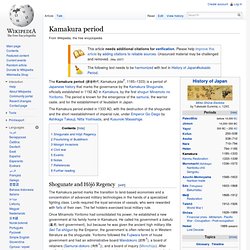
, 1185–1333) is a period of Japanese history that marks the governance by the Kamakura Shogunate, officially established in 1192 AD in Kamakura, by the first shogun Minamoto no Yoritomo. The period is known for the emergence of the samurai, the warrior caste, and for the establishment of feudalism in Japan. The Kamakura period ended in 1333 AD, with the destruction of the shogunate and the short reestablishment of imperial rule, under Emperor Go-Daigo by Ashikaga Takauji, Nitta Yoshisada, and Kusunoki Masashige. Shogunate and Hōjō Regency[edit] The Kamakura period marks the transition to land-based economies and a concentration of advanced military technologies in the hands of a specialized fighting class. Once Minamoto Yoritomo had consolidated his power, he established a new government at his family home in Kamakura. Despite a strong beginning, Yoritomo failed to consolidate the leadership of his family on a lasting basis.
Kenmu Restoration. The Kenmu (or Kemmu) Restoration (建武の新政, Kenmu no shinsei?)
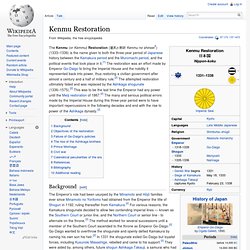
(1333–1336) is the name given to both the three-year period of Japanese history between the Kamakura period and the Muromachi period, and the political events that took place in it.[1] The restoration was an effort made by Emperor Go-Daigo to bring the Imperial House and the nobility it represented back into power, thus restoring a civilian government after almost a century and a half of military rule.[2] The attempted restoration ultimately failed and was replaced by the Ashikaga shogunate (1336–1575).[2] This was to be the last time the Emperor had any power until the Meiji restoration of 1867.[2] The many and serious political errors made by the Imperial House during this three-year period were to have important repercussions in the following decades and end with the rise to power of the Ashikaga dynasty.[2] Background[edit] Objectives of the restoration[edit] Emperor Go-Daigo Failure of Go-Daigo's policies[edit] Civil war[edit]
Muromachi period. Sengoku period. The Sengoku period (戦国時代, Sengoku jidai?
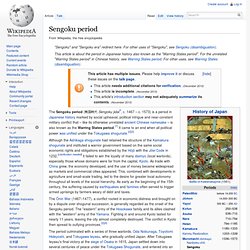
, c. 1467 – c. 1573) is a period in Japanese history marked by social upheaval, political intrigue and near-constant military conflict that – like its otherwise unrelated ancient Chinese namesake – is also known as the Warring States period.[1] It came to an end when all political power was unified under the Tokugawa shogunate.[2][3] Although the Ashikaga shogunate had retained the structure of the Kamakura shogunate and instituted a warrior government based on the same social economic rights and obligations established by the Hōjō with the Jōei Code in 1232,[clarification needed] it failed to win the loyalty of many daimyo (local warlords), especially those whose domains were far from the capital, Kyoto. As trade with China grew, the economy developed, and the use of money became widespread as markets and commercial cities appeared.
Gekokujō[edit] Unification[edit] Notable people[edit] Japan in the late 16th century Ōzutsu (Big Gun) Azuchi–Momoyama period. Edo period. The Edo period (江戸時代, Edo jidai?)

, or Tokugawa period (徳川時代, Tokugawa jidai?) , is the period between 1603 and 1867 in the history of Japan, when Japanese society was under the rule of the Tokugawa shogunate and the country's 300 regional Daimyo. The period was characterized by economic growth, strict social order, isolationist foreign policies, environmental protection policies,[1][2][3][4] and popular enjoyment of arts and culture.
The shogunate was officially established in Edo on March 24, 1603, by Tokugawa Ieyasu. Sakoku. A 17th-century European engraving depicting a Dutch tributary embassy to the Tokugawa's residence.

With the change to isolationism the bakufu sought to create a tribute system with China as the model. The 1710 Ryukyuan mission, in this scroll a Japanese printer depicts Ryukyuan guards and a music band escorting the envoy and his officials through Edo. With increasingly distant relations with China, the submission of Ryukyu by Satsuma allowed Japan to trade with China via the Ryukyus. Sakoku (鎖国? , "chained country") was the foreign relations policy of Japan under which no foreigner could enter nor could any Japanese leave the country on penalty of death.
The term Sakoku originates from the manuscript work Sakoku-ron (「鎖国論」?) Trade under sakoku[edit] Japan traded at this time with five entities, through four "gateways". These two different groups of trade basically reflected a pattern of incoming and outgoing trade. Terminology[edit] Rationale[edit] Challenges to seclusion[edit] Bakumatsu. Although these two groups were the most visible powers, many other factions attempted to use the chaos of Bakumatsu to seize personal power.[1][page needed] Furthermore there were two other main driving forces for dissent: first, growing resentment on the part of the tozama daimyo (or outside lords), and second, growing anti-western sentiment following the arrival of Matthew C.

Perry. The first related to those lords who had fought against Tokugawa forces at the Battle of Sekigahara in 1600 and had from that point on been excluded permanently from all powerful positions within the shogunate.